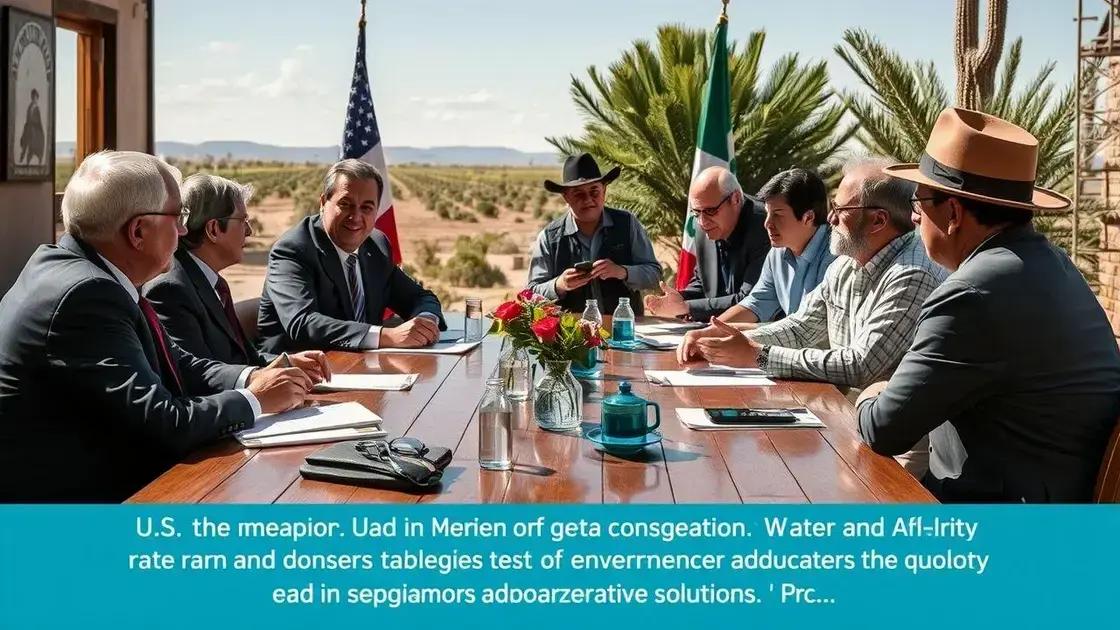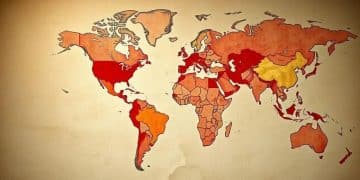Trump escalates tariff threats in ongoing Mexico water dispute

Trump escalates tariff threats in the ongoing Mexico water dispute, creating significant tensions and economic impacts while highlighting the need for collaboration on shared water resources.
Trump escalates tariff threats in ongoing Mexico water dispute as negotiations heat up, leaving many to wonder about the implications for trade and cooperation.
Background of the Mexico water dispute
The background of the Mexico water dispute sheds light on the factors that have led to ongoing tensions between the United States and Mexico. Water scarcity is an urgent issue in both nations, especially in regions heavily reliant on shared water sources. This dispute has deep historical roots, making it important to understand its origins and its evolution over time.
Historical context
The conflict began with the 1950s water treaty which aimed to share the waters of the Rio Grande. However, as climate change worsens and populations grow, both countries struggle to meet their water needs. This has created friction over water allocations, leading to disagreements and heightened tensions.
Current factors
Recent years have seen significant droughts in both countries, intensifying the strain on mutual water supplies. Additionally, political pressures in the U.S. have prompted leaders to take a tougher stance, with tariffs being proposed as a bargaining tool. This has led many to wonder about the future of diplomatic relations.
- Drought conditions affecting both nations
- Impact of climate change on water resources
- Political motivations behind the tariff threats
- Historical agreements and their implications
As discussions continue, the focus must also include the disparities in water usage between communities. For instance, agricultural demands in the U.S. often take priority over urban needs in Mexico, resulting in a lack of equity in water distribution.
International implications
The ongoing dispute not only impacts local communities but also has broader international ramifications. Both countries must cooperate on water management to avoid escalating conflicts that could threaten regional stability. Considering the different interests at play, maintaining open channels of dialogue is vital for achieving a fair resolution.
Key players and their interests

In the complex web of the Mexico water dispute, several key players hold significant stakes. Understanding their interests is crucial to grasping the ongoing tensions. The primary players include the U.S. government, the Mexican government, local farmers, and environmental groups.
The U.S. government
The U.S. has a vested interest in maintaining a stable water supply for its agricultural sector. This focus can lead to policies that prioritize American farmers’ needs, often at the expense of their Mexican counterparts. Additionally, the government’s stance on tariffs can be influenced by domestic political pressures, heightening tensions in negotiations.
The Mexican government
Mexico’s interests revolve around ensuring adequate water access for its citizens and agricultural sectors. The country is particularly vulnerable to drought conditions, making access to shared water resources even more critical. Balancing the needs of various regions within Mexico while negotiating with the U.S. is a significant challenge for its government.
- Protection of water rights for local communities
- Economic stability in agricultural sectors
- Environmental conservation efforts
- Political pressure from lobbying groups
Local farmers in both countries are another vital element in this dispute. In the U.S., farmers often advocate for policies that ensure continued water access for agriculture, which sometimes conflicts with Mexican farmers who need the same resources. This competition can heighten tensions between the two nations. Environmental groups also play a role, pushing for sustainable management of water resources to safeguard ecosystems, which can complicate negotiations as they advocate for reduced water usage.
In this intricate scenario, the dynamics shift continually depending on political situations, weather patterns, and international relations. Each player’s interests can affect the overall balance of negotiations and lead to significant consequences for both nations.
Impact of tariff threats on US-Mexico relations
The impact of tariff threats on US-Mexico relations is significant and multilayered. As the current administration ramps up its rhetoric regarding tariffs, both countries face increasing pressure to address long-standing issues. These threats can alter the dynamics of diplomatic conversations, leaving both sides wondering how to move forward.
Economic repercussions
Tariff threats can lead to economic instability on both sides of the border. For instance, a proposed tariff on goods imported from Mexico can increase prices for American consumers. Conversely, Mexican exporters might face reduced demand for their products, impacting their economy. The ripple effects can lead to losses in jobs and overall economic downturn for both nations.
Political ramifications
The political landscape is also affected as leaders use tariff threats to signal strength to their constituents. This posturing can hinder negotiations, making it challenging to find common ground. Local businesses and farmers, deeply intertwined with cross-border trade, may lobby for more favorable relations, leading to competing interests within each country.
- Increased uncertainty in trade agreements
- Strained diplomatic relations
- Potential backlash from businesses on both sides
- Heightened tensions leading to protests and advocacy efforts
Moreover, these threats can impact bilateral cooperation in other areas, such as immigration and drug trafficking. When trade relations become contentious, it can be harder to work together on these complex issues. Trust diminishes, and fears of further conflict can overshadow dialogue. Therefore, finding a balance between ensuring national interests and maintaining diplomatic goodwill becomes crucial.
As both countries navigate through these turbulent waters, the long-term effects of tariff threats remain to be seen. The stakes are high, making it critical for leaders to engage in constructive dialogue and seek solutions that benefit both nations.
Potential solutions and diplomatic efforts

The potential solutions and diplomatic efforts surrounding the Mexico water dispute are critical in finding a resolution that benefits both nations. As tensions rise, exploring various approaches can pave the way for cooperation and mutual understanding.
Negotiated agreements
One potential solution is the establishment of new negotiated agreements that reflect current realities. These agreements could focus on fair water allocation based on the changing climate and population needs. By prioritizing collaboration, both countries can work toward sustainable water management practices that address the concerns of farmers and citizens alike.
Water conservation initiatives
Implementing water conservation initiatives is another effective strategy. Programs that promote efficient use of water resources can help alleviate pressure on shared supplies. For example, both countries could invest in technologies that reduce water waste in agriculture. This not only conserves water but also supports farmers in maximizing their yields.
- Joint investment in water infrastructure
- Enhanced monitoring of water usage
- Community education on water conservation
- Support for innovative technologies
Diplomatic efforts should also emphasize the importance of ongoing dialogue between key stakeholders. Regular meetings between U.S. and Mexican officials, along with involvement from farmers and environmental advocates, can foster a sense of shared responsibility. This engagement encourages transparency and builds trust, which is vital for resolving disputes.
Furthermore, leveraging international organizations could provide additional support in mediating discussions and finding solutions. By involving neutral parties, both nations may feel more secure in addressing sensitive issues, ultimately paving the way for healthier relationships and sustainable management of water resources.
FAQ – Questions about the US-Mexico Water Dispute
What are the main issues in the US-Mexico water dispute?
The main issues include water allocation, drought conditions, and competing agricultural needs between the two countries.
How do tariff threats affect relations between the US and Mexico?
Tariff threats can create economic instability and strain diplomatic relations, complicating negotiations around shared water resources.
What solutions are being proposed for the water dispute?
Proposed solutions include negotiated agreements for fair water allocation and initiatives to promote water conservation.
Why is stakeholder engagement important in resolving the dispute?
Engaging stakeholders, such as farmers and environmentalists, helps build trust and ensures that diverse interests are represented in negotiations.






